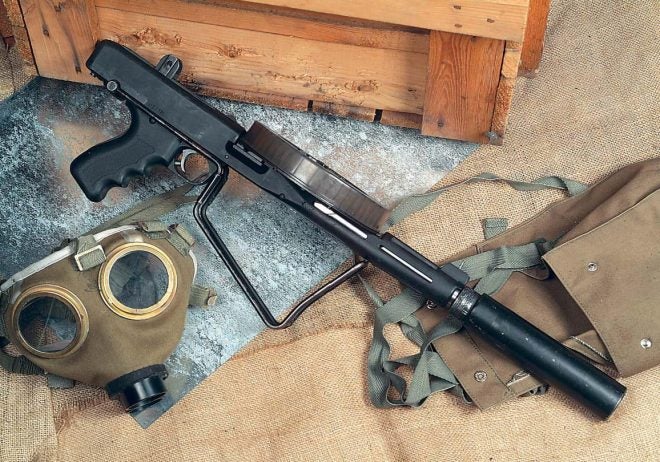Welcome back to The Rimfire Report. In this ongoing series of articles we explore, discuss, and examine various firearms, ammunition, and topics surrounding the rimfire world. This week we’re exploring a somewhat unknown firearm that hails from Slovenia – the MGV-176 22LR submachine gun.
The Rimfire Report: The MGV-176 22LR Submachine Gun
For the keen-eyed reader, the MGV-176 will bear a striking resemblance to the American Arms International American-180 submachine gun. In truth, both guns share a lot of the same basic design principles and overall appearance but the MGV-176 has some notable improvements which set it apart from its American counterpart.
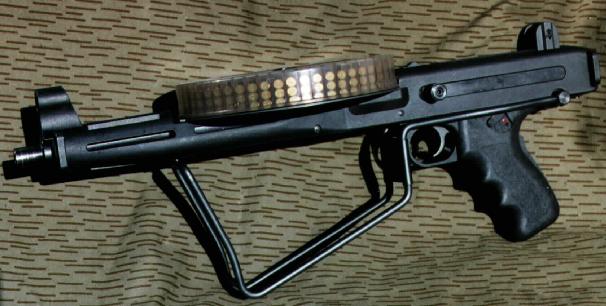
Photo Source: nationstates.net
MGV-176 Specifications
- Country of Origin: Yugoslavia (Slovenia)
- Manufacturer: Gorenje Sovd
- Produced: 1980 – Present
- Operation: Blowback, Open Bolt
- Caliber: 22 Long Rifle
- Length (folded stock): 18.9″
- Length (extended stock): 31.3″
- Barrel Length: 10.2″
- Loaded Weight: 7.5 lbs
- Magazine Capacity: 162-round detachable pan magazine
- Cyclic Rate: 1200-1600 RPM
- Accessories: Included Clamp-on style suppressor
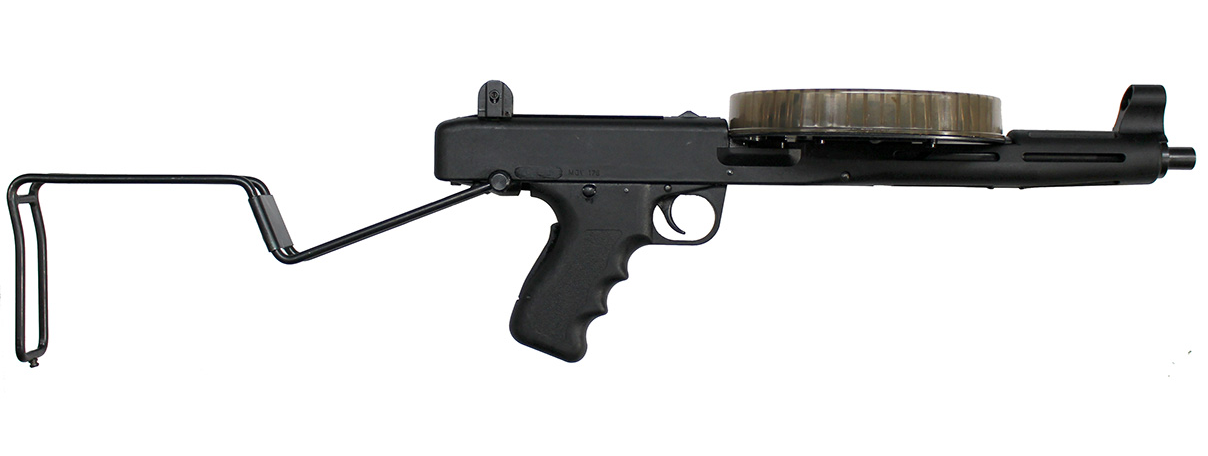
Photo Source: liveauctioneers.com
History
The MVG-176 was first produced at the beginning of 1980 by the Gorenje Sovd factory in the northeast city of Velenje, Slovenia. Later on, international marketing and export of the submachine gun were taken over by a company called Orbis.
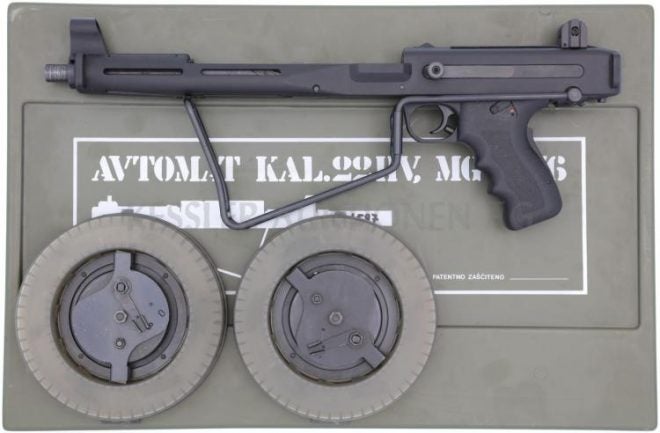
Photo Source: invalueable.com
The initial use of the weapon was geared towards police use to provide users with a high rate of fire weapon with as little recoil possible. Given those needs, the designers chose to go with the inexpensive 22LR cartridge as it was one of the most widely available calibers offered.
The weapon has seen use by police forces in Slovenia as well as the Territorial Defense militia during the Slovenian war of Independence. In Croatia, the firearm saw intense use during the early days of the Croatian War of Independence with the Croatian police and the Yugoslav Peoples Army. The battle ultimately resulted in a Croatian victory with over 250 tanks, 35 naval vessels, and 180,000 small arms captured as well as 3,000 Jugoslovenska Norodna Armija (JNA) officers switching allegiance to Croatia.

Photo Source: liveauctioneers.com
Although the submachine gun seemed to serve the Croatians well, as soon as the Croatian Army was formed the MGV-176 was replaced by other, more popular submachine guns chambered in 9mm. Today it is found as a common weapon used by criminals due to its high rate of fire and its availability in the Croatian and Slovenian regions.
Inspired by the American-180
The American-180 submachine gun was designed by Richard Casull and Kerm Eskelson in the 60s with the intent of selling it to government agencies. Somewhat resembling a Thompson submachine gun, the American-180 was first marketed to agencies as the Casull M290 Carbine in 1965. Unfortunately, the gun did not sell very well with only 70 total units being made, and eventually, Richard and Kerm sold the rights to the American-180 to the American Mining and Development Company (AIC) in 1969.

Note: The American-180 when fully loaded weighed over 10lbs! Source: Dealer NFA Inc
Later on, the gun was once again put into production but with a reduced pan magazine capacity down from 290 to 177 total rounds. Once again the American-180 was marketed to law enforcement agencies and military as the American 180 M-2 Submachine Gun. The weapon saw actual use with the Rhodesian SAS.
The gun was made from wood or plastic and the remainder of the gun was made from steel and aluminum with many parts being machined. AIC partnered with Austrian gun company Voere and about 5,000 of the submachine guns were produced before discontinuation and eventual marketing by American Arms Incorporated in the late 1980s.
MGV-176 Improvements over the American-180
The MGV-176 was offered with two 162-round pan magazines, a maintenance kit and an over the barrel clamp-on suppressor. If only we could get kits like this in the United States without all the paperwork!
As opposed to the almost entirely steel and aluminum construction of the American-180, the MGV-176 was constructed from more futuristic materials made available in the 1980s. The upper receiver was made of impact-resistant plastic, which also had the added benefit of lightening the gun. The receiver comes ready with pre-installed iron sights but is also able to accept optical sights.
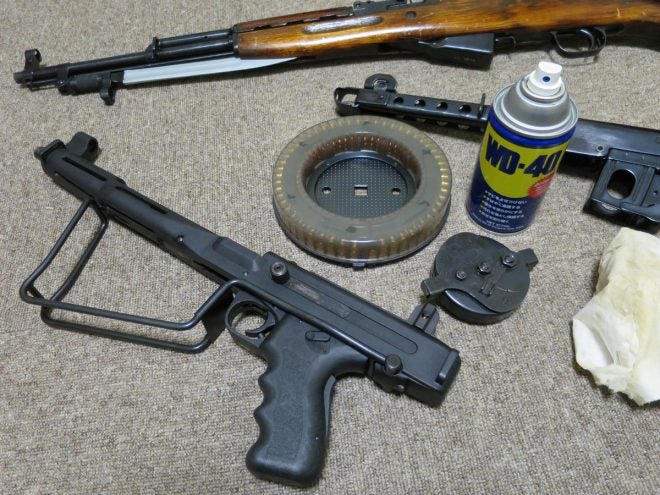
Photo Source: Twitter
The bolt is made from machined steel and holds a fixed firing pin with a ledge shaped end more suitable for activating the rim primers. The folding stock fits neatly into a notch in the forward part of the barrel shroud and out of the way of the ejection port and charging handle so that the gun can be discharged from either folded or extended stock positions.
While the American-180 did not gain a selector switch until much later in its development, the MGV-176, on the other hand, has options for semi-auto, full-auto, and safe modes with its selector. The safety-selector also acts as a bolt lock, meaning the gun cannot be cocked with the safety on.
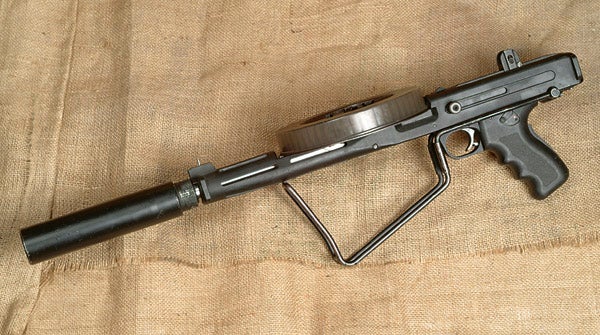
Image Source: kaliberinfo.hu
The trigger mechanism is made from machined steel parts that are conducive to a drop safe weapon. Both the safety and the grip safety lock the sear in place which prevents the gun from being discharged when dropped even if the bolt is cocked back.
Dedicated Suppressor
By far the most interesting feature of the MGV-176 is its integrated suppressor. While the suppressor is about 6.7-inches long, it only adds about 5.9-inches to the gun’s overall length. The suppressor is attached by a clamp bushing over the muzzle of the gun when a locking nut is turned. This means that the barrel is easier to manufacture since it does not need threading for the suppressor, although testing models were made with threaded barrels using Finnish-made BR-TUOTE suppressors.

Photo Source: liveauctioneers.com
Conclusions
Overall it seems that the MGV-176 held a lot of improvements and potential from a submachinegun standpoint. Being nearly 3lbs lighter than the American-180 meant that this submachine gun would be great in the hands of a police officer or soldier needing to send a barrage of suppressive fire downrange with little to no recoil.
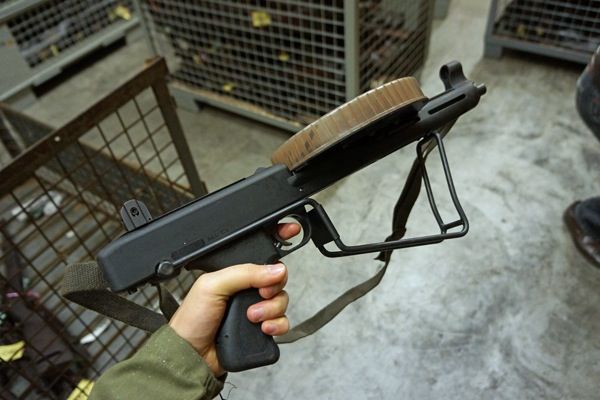
Photo Source: Dennis H
However, it seems that the volume of fire in a small caliber is not what agencies or militaries want. As with the American-180, the MGV-176 has fallen completely out of use and is basically a novelty item for collectors and recreational shooters. I’d like to hear your guy’s thoughts on a rimfire submachine gun – do you feel like it’s a valid and solid concept? If not, why doesn’t it work? As always thank you for stopping by to read The Rimfire Report and we’ll see you in the next one!
 Your Privacy Choices
Your Privacy Choices
